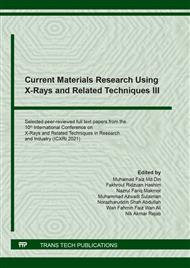p.592
p.598
p.605
p.612
p.621
p.626
p.633
p.639
p.645
Compressive Strength of Concrete Bricks with Recycled Concrete Sludge Waste
Abstract:
Owing to the inability of waste concrete to be recycled, unlike aluminium or glass, it is one of the most harmful substances to the environment. Thus, most of the waste concrete was poured in every available space, resulting in environmental contamination due to the chemical content of the waste concrete. This involves the fabrication and characterization of cement bricks’ compressive strength made from concrete sludge waste in order to investigate the feasibility of re using waste concrete. The concrete waste was to substitute the cement composition within the bricks. The composition of cement and waste concrete is varied to investigate effect of its compressive strength and its microstructure. In general, the optimal formulation is 100 wt % cement and 0 wt % waste, with a compressive strength of up to 12 MPa on average. Increasing the waste composition by 50% reduces the compressive strength of the concrete bricks to 2MPa which limiting the range of application suitable with its properties.
Info:
Periodical:
Pages:
621-625
Citation:
Online since:
January 2022
Keywords:
Price:
Сopyright:
© 2022 Trans Tech Publications Ltd. All Rights Reserved
Share:
Citation:


